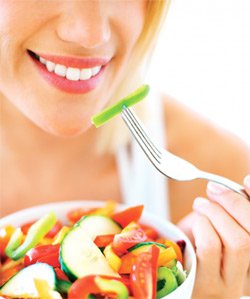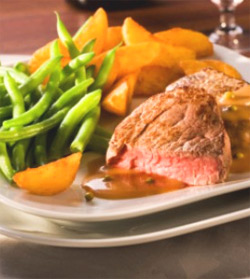|
|
|
 ,
,
Font size |
Dietary Management of Colitis
Eat Plenty Of
-
 Fruit and cooked green leafy vegetables for soluble
fibre Fruit and cooked green leafy vegetables for soluble
fibre
-
Oily fish such as salmon, sardines and mackerel for
vitamin D
-
Foods rich in beta carotene
-
Liver for vitamin A, unless
pregnant
AVOID
-
Bran, nuts, seeds and sweetcorn
-
Dairy products
(cheese, cottage cheese, cream)
Soluble fibre found in fruits,
vegetables, grains, oatmeal, and dried beans helps to lower
cholesterol and prevent such diseases as
colon cancer and
diabetes.
|
Although diet cannot cure colitis- adjustments to the diet may help to reduce
some of the symptoms to a more tolerable level. For example, a diet rich in
soluble Fibre, is recommended for people who have colitis, although foods high
in insoluble fibre, such as bran, nuts, seeds and sweet corn, are probably best
avoided. The fibre may further irritate the colon, stimulate bowel contractions
and so increase the likelihood of diarrhoea.
Colitis is an inflammatory disease of the colon or rectum. It affects about four
to six people in 100 000, and is slightly more common in women than in men. The
onset of ulcerative colitis peaks between the ages of 20 and 25 years. The
prognosis for sufferers depends on the severity and duration of the active
disease: when the disease is active, it produces swelling, bleeding and
ulceration of the lining of the colon and causes pain and urgent diarrhoea.
Although some 60 percent of sufferers have only a mild form of the disease, at
least 30 percent will require surgical removal of part or all of the colon
within the first three years. And as many as 97 percent of people who develop
uncreative colitis will have at least one relapse over a ten-year period.
 Adequate nutrition is very important in colitis, especially if you are
recovering from a flare-up or are reducing your intake of food in order to
lessen diarrhoea. Care should therefore be taken to include adequate
protein,
calories, vitamins
A,
C,
D,
B12 and
folate,
calcium,
iron and
zinc. This means
eating as wide a variety of foods as possible without exacerbating the
inflammation. Eat liver once a week for extra vitamin A (except when pregnant)
and orange-fleshed fruits and vegetables for beta carotene, which the body
converts to vitamin A. Fresh or canned salmon, sardines and mackerel provide
vitamin D. Liver, fish, pork and eggs are all good sources of B12; dark green
leafy vegetables supply folate and fruit, contain soluble fibre; cheese
and yoghurt are good sources of calcium; and zinc is found in seafood,
especially oysters. Adequate nutrition is very important in colitis, especially if you are
recovering from a flare-up or are reducing your intake of food in order to
lessen diarrhoea. Care should therefore be taken to include adequate
protein,
calories, vitamins
A,
C,
D,
B12 and
folate,
calcium,
iron and
zinc. This means
eating as wide a variety of foods as possible without exacerbating the
inflammation. Eat liver once a week for extra vitamin A (except when pregnant)
and orange-fleshed fruits and vegetables for beta carotene, which the body
converts to vitamin A. Fresh or canned salmon, sardines and mackerel provide
vitamin D. Liver, fish, pork and eggs are all good sources of B12; dark green
leafy vegetables supply folate and fruit, contain soluble fibre; cheese
and yoghurt are good sources of calcium; and zinc is found in seafood,
especially oysters.
Dairy products (cheese, cottage cheese, cream) must be avoided. In
case, you just cannot live without these products, you can eat them but in
reasonable quantities. Going overboard eating Dairy products may complicate the
symptoms of ulcerative colitis.
Active Colitis (Flare-up stage) is the time when your stool samples have
traces of blood. And this is the time, you need to be extra careful with the
food items that you intake. This is the time that you say �No� to cabbage family
vegetables, onions, tomato seeds, mushrooms. All these are high-fiber content
food items and when consumed, pass through the digestive tract without them
being digested completely. This means that these food items adhere to the wall
of the colon when it is inflamed which also causes colon irritation.
Anaemia is a fairly common problem with ulcerative colitis, as there is
often bleeding from the area of inflammation. It is important, therefore, to eat
plenty of dietary iron. The most available form of iron is in red meat,
especially liver. To help the body to absorb iron from vegetables, meals should
contain a good source of vitamin C such as fresh orange juice.
All that you need to do is to ensure that you put these tips into practice is
to adhere to them in your colitis diet plan. While simple colitis is nowhere
near a life threatening disorder, its ulcerative form is more serious and needs
to be managed by being given the attention of a proper diet.
Dated 09 March 2015
Related Links
|
|
|
|
|









